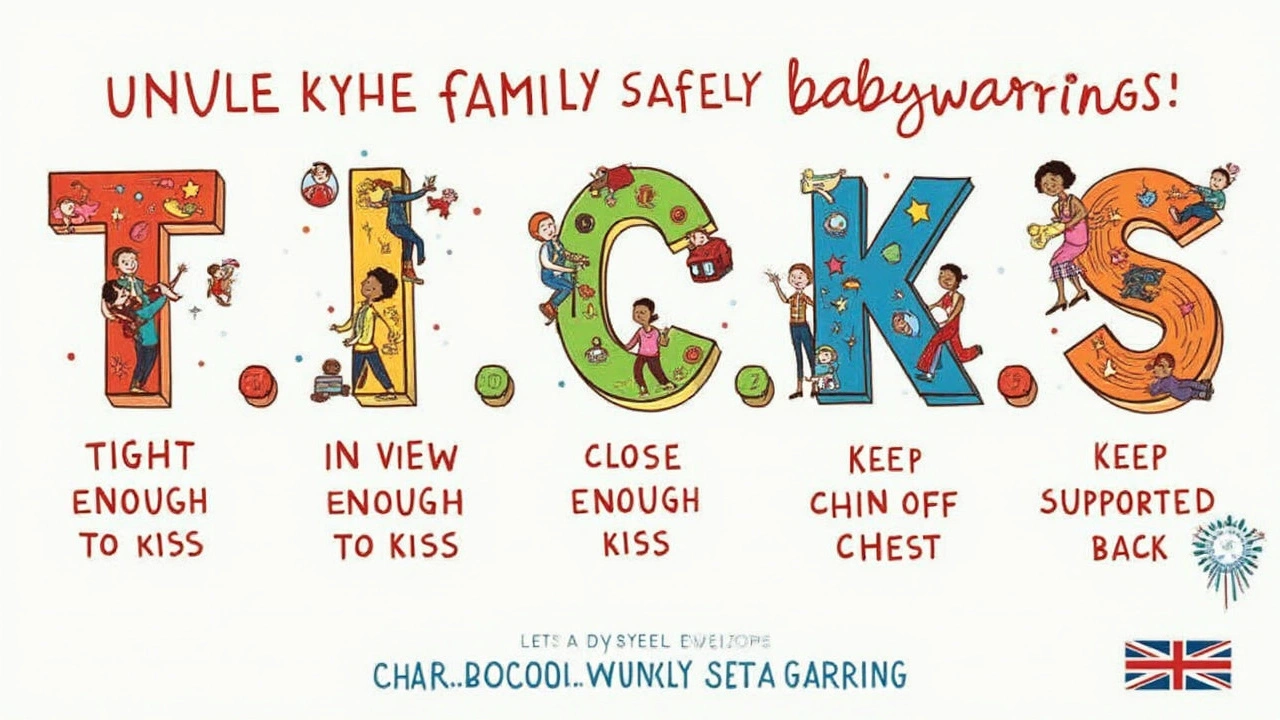So here’s a fun story: years ago in Melbourne, you'd spot parents everywhere—coffee in hand, baby nestled in a wrap—looking effortlessly cool and confident. But, did you know there’s a simple memory trick that keeps those tiny passengers as safe as they look? Some new parents think babywearing is all instinct, but there’s more to it. Every year, thousands of Aussie mums and dads turn to the TICKS baby wearing rule—a catchy acronym that’s gone global, cropping up in everything from midwife classes to parenting podcasts. It’s not another bit of cryptic baby gear lingo, either. TICKS is all about not stuffing up the essentials: your baby's safety and comfort. It’s actually short for Tight, In View, Close Enough to Kiss, Keep Chin Off Chest, and Supported Back. Five guidelines, easy to remember, but totally crucial for keeping your little one happy and breathing easy—whether you’re running errands, hiking the Yarra trails, or just trying to rock that magical ten-minute nap.
Where TICKS Came From (And Why It Matters)
The TICKS rule wasn’t dreamed up by a clever marketing team or some overzealous influencer; it was born out of real concern. Around 2009, reports from the UK and Australia highlighted tragic accidents linked to unsafe babywearing, especially with slings. Infant carriers, wraps, and rings used by loving parents weren’t always safe if worn the wrong way. Here in Australia, Red Nose and Kidsafe quickly jumped on board, sharing TICKS across hospitals, clinics, and Facebook mum groups. And let’s be honest, there’s something comforting in hearing the same advice from your maternal health nurse at Royal Women’s as from your local online parenting group.
The point of TICKS is simple: keep baby’s airway free, ensure they can breathe, and prevent hidden risks like positional asphyxia (which means baby’s chin curling into their chest, cutting off airflow). Evidence-based and endorsed by major safety organizations, TICKS became a kind of lifeline for nervous new parents. Research by the Australian Competition and Consumer Commission (ACCC) in 2023 found that reminding parents about safety guidelines like TICKS cut babywearing-related accidents by 40% over five years—kind of a big deal.
We’re not just talking about newborns, either. TICKS applies for toddlers hanging out on your back while you shop or trek, too. The universality of it is what makes it stick—pun intended. Whether you’re using a structured carrier, stretchy wrap, or piece of repurposed jersey cotton, those five little letters are the same. The world’s biggest babywearing brands, from Ergobaby to BabyBjörn, even include the TICKS steps on care tags and instruction docs. That way, no matter where you got your carrier or who gifted it to you, there’s a universal checklist to run through.
So if you need backup the next time a well-meaning relative points at your carrier and frowns, you can drop the facts. TICKS isn’t just a handy acronym; it’s a research-backed, hospital-approved tool that’s actually helped save lives and up confidence when wearing your baby out in real life.
Breaking Down T.I.C.K.S – The Five Babywearing Safety Rules
The heart of baby carrier safety is right there in those five letters—T.I.C.K.S. Every letter means something specific, and each point helps you problem-solve issues fast. Here’s how it works, step by step:
- TIGHT — The carrier sling should be tight, with your baby snug against you. Too loose means your baby could slump down, putting pressure on their airway. If you can easily slide your hand between your baby and the fabric, tighten it up. A fitted carrier also helps with your own comfort: less sagging means less back strain.
- IN VIEW AT ALL TIMES — When you glance down, you should always see your baby’s face. The fabric shouldn’t cover their mouth or nose. If you need to pull fabric away or shift the carrier to get a peek, it’s not right. Think of it like driving—if you can’t see the road, you wouldn’t keep going. Same goes for your baby’s little face.
- CLOSE ENOUGH TO KISS — This one makes you smile, but it’s a serious check: your baby’s head should be as close to your chin as possible. Lean down—you should be able to kiss their forehead without straining. If you can’t, baby’s probably too low on your torso (danger zone for airway issues).
- KEEP CHIN OFF THE CHEST — The biggest risk is baby’s chin curling onto their chest, which can cut off breathing in seconds (positional asphyxia). The fix? Their chin should be up and away from their body, with at least a finger’s width gap between the chin and chest. If in doubt, gently adjust.
- SUPPORTED BACK — Babies need spinal support. Their back should be supported in a natural position, with their tummy and chest against you. No slouching! For newborns, go for a natural C-curve; older babies can hold up their head more but still need steady support. And their knees? Higher than their bum means happy hips.
Let’s be real—those rules do not change, whether you’re using a fancy imported linen wrap or a homemade 1970s carrier handed down from grandma. They’re non-negotiable, and probably the best quick-safety check around. If you think you’ve nailed all five, you’re good to go!
Want some quick stats? Here’s a table based on ACCC data from 2024 showing common babywearing mistakes among new parents:
| Mistake | Reported (%) |
|---|---|
| Loose or sagging carriers | 30% |
| Baby’s face covered | 18% |
| Baby positioned too low | 15% |
| Chin pressed to chest | 8% |
| Unsupported back | 12% |
Seeing those numbers makes it obvious that sticking to TICKS isn’t just nit-picking; it’s seriously effective prevention.

Babywearing in Real Life: Australian Experiences, Myths and Mistakes
Heads up: nobody gets babywearing perfect on the first go. I’ve seen chili-spice stains on wraps (hello, lunchtime mishaps), grumpy bubs wiggling mid-tram ride, and more than one “dad knot” gone wrong at a winter market. One common myth is that ALL babywearing is naturally safe, just because it’s been around forever, but the reality? Even with soft structured carriers, doing it wrong can leave baby poorly positioned or even at risk of falling.
Melbourne’s parks and neighbourhoods are packed with parents trying out everything from classic Hug-a-Bub wraps to Korean podaegi carriers. What’s wild is how many parents guess or wing it at first, thinking it’s just about getting the thing on and hope for the best. (And don’t even start on rogue YouTube tutorials; let’s just say not all “life hacks” are safe.) If you ever find yourself fiddling with extra straps or confusing instructions, aim for the TICKS rules first before anything else.
Experienced babywearers love trading tips at local bubs-and-cups meetups. Want a classic hack for getting baby into the right spot? Stand in front of a mirror, run through TICKS one by one, and make adjustments until every guideline is met. Feeling brave? Try filming yourself and watching your technique—sometimes what feels secure isn’t actually right.
There’s also a running debate about facing baby outwards (let’s call it “kangaroo facing”). Some brands market it as fun and interactive, but the TICKS rule was designed for inwards-facing positions, especially under six months. Facing out can be safe for older babies, but only with strong neck control and in short bursts—otherwise, baby’s airway, hip position, and overstimulation become risks. When in doubt, stick with your baby’s chest against yours. (Bonus: It soothes cranky newborns and helps with attachment, without the need for fancy extras.)
And let’s talk temperature: in Melbourne’s famously changing weather, mums swap between light bamboo wraps and thick soft-structure carriers like they swap jumpers. TICKS still applies—make sure baby’s airway is clear and they aren’t overheating. Always check their neck, chest, and back for sweat or dampness, especially in summer. In cold months, zip yourself and baby into your own jacket, rather than bunting them up in bulky snowsuits—multiple layers can make them overheat and slip down inside a carrier. Safety trumps cute winter pics every time.
Choosing Your Carrier: Matching Gear to the TICKS Rule
Picking a baby carrier isn’t just about style or brand. It’s about matching your lifestyle and baby’s needs to something that actually supports safety. Fans of woven wraps brag about their adjustability, while ring sling lovers swear by the speed. Here’s a cheat sheet for common carrier types, and their TICKS-friendly features:
- Soft Structured Carriers: These have buckles and padding. Great for dads and for longer outings. Look for adjustable neck and back support, and make sure baby’s position checks all the TICKS boxes, especially tightness and chin position.
- Stretchy Wraps: The newborn favourite. Perfect if you want that cuddly kangaroo-pouch vibe, but easy to tie too loosely. Best for babies under 8kg. Double-check TICKS after tying and once baby is inside.
- Ring Slings: Sling through a pair of rings—it’s faster than you’d think, super handy for quick grocery runs. Check regularly for tightness around the top rail (upper edge) and baby’s face in view.
- Mei Tai (Asian-style Carriers): Square panel plus waist and shoulder straps. Gives a custom fit. Good for growing bubs but still needs checking every time you tie.
- Woven Wraps: Endless ways to tie and super durable, but takes a bit of practice. Always check knot security and run through TICKS slowly the first few times.
Skip “head support pillows” or thick inserts if possible—they might seem helpful but sometimes push baby’s chin down or force unnatural positions. The key? Aim for a natural “froggy” leg squat, baby’s bum lower than knees, clear airways, and that magical “kissable” head level. If your carrier doesn’t help you ace TICKS, it might be time for a swap or upgrade.
One more tip: While most carriers in Australia must pass ACCC standards for safety labeling, secondhand or international carriers might not have the latest safety design. Always give them a once-over for stitching, fabric integrity, and the TICKS test before use.

Expert Tips, Troubleshooting, and Getting Support
Stuck on sling knots? Confused by carrier clips? You’re definitely not alone. Babywearing consultants (yes, they exist!) can be lifesavers if you want a hands-on demo and live in a city like Melbourne. Local libraries, maternal health nurse clinics, and even baby gear shops regularly run pop-up “wearing workshops”—and they’ll walk you through TICKS while you get practical tips for different ages or body types. Don’t underestimate the power of a wise old grandparent, either—they’ve probably done this a dozen times and love passing on tricks.
Common troubleshooting hacks: If your baby fusses or cries in a carrier, double-check all five TICKS points, adjust their position, and watch for signs of overheating or constricted airflow. If your back or shoulders ache, try shifting strap height, or tightening the waistband. And if you’re ever unsure, get another adult to check your setup or video-chat a friend who’s “been there, worn that.”
Still struggling? Online support groups for babywearing parents can offer real-world feedback, usually faster than a generic FAQ sheet. Android and iOS even have handy apps now—a “TICKS checklist” app popped up in 2024 that walks parents through a position test before heading out the door.
The most valuable advice? Trust your gut, but trust TICKS more when it comes to safety. It’s not about chasing perfection; it’s about creating small habits that stick. Run through the checklist every time, switch up carriers until you find your groove, and don’t sweat the random spit-up or snack crumbs. Babies don’t come with manuals, but the five steps of TICKS? That one’s short enough for anyone to memorise—even on three hours of sleep.
So next time you walk the Tan, squeeze into that crowded tram, or dash out for milk at midnight, remember: babywearing isn’t just about bonding or convenience. TICKS is your simple, science-backed everything-check, whether you’re brand new to carriers or a seasoned hands-free multitasker. Happy wearing!
